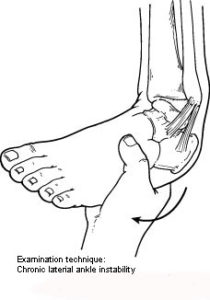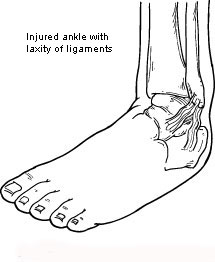What Is Chronic Ankle Instability?
Chronic ankle instability is a condition characterized by a recurring “giving way” of the outer (lateral) side of the ankle. This condition often develops after repeated ankle sprains. Usually the “giving way” occurs while walking or doing other activities, but it can also happen when you’re just standing. Many athletes, as well as others, suffer from chronic ankle instability.
People with chronic ankle instability often complain of:
- A repeated turning of the ankle, especially on uneven surfaces or when participating in sports
- Persistent (chronic) discomfort and swelling
- Pain or tenderness
What Causes It?

Chronic ankle instability usually develops following an ankle sprain that has not adequately healed or was not rehabilitated completely. When you sprain your ankle, the connective tissues (ligaments) are stretched or torn. The ability to balance is often affected. Proper rehabilitation is needed to strengthen the muscles around the ankle and “retrain” the tissues within the ankle that affect balance.
Repeated ankle sprains often cause—and perpetuate—chronic ankle instability. Having an ankle that gives way increases your chances of spraining your ankle repeatedly. Each subsequent sprain leads to further weakening (or stretching) of the ligaments— resulting in greater instability and the likelihood of developing additional problems in the ankle.
Evaluation and Diagnosis
If your ankle feels wobbly or unstable and gives way repeatedly, or if you’ve had recurring ankle sprains, see a foot and ankle surgeon to have your condition evaluated and treated. Chronic ankle instability that is left untreated leads to continued instability, activity limitations, arthritis, and tendon problems.In evaluating and diagnosing your condition, the foot and ankle surgeon will ask you about any previous ankle injuries and instability. Then he or she will examine your ankle to check for tender areas, signs of swelling, and instability of your ankle as shown in the illustration. X-rays, CT scans, or MRIs may be helpful in further evaluating the ankle.
Nonsurgical Treatment Options
Treatment for chronic ankle instability is based on the results of the examination and tests, as well as on the patient’s level of activity.
- Physical Therapy (Physical therapy involves various treatments and exercises to strengthen the ankle, improve balance and range of motion, and retrain your muscles. As you progress through rehabilitation, you may also receive training that relates specifically to your activities or sport.)
- Bracing(Some patients wear an ankle brace to gain support for the ankle and keep the ankle from turning. Bracing also helps prevent additional ankle sprains.)
- Medications (Non-steroidal anti- inflammatory drugs (NSAIDs), such as ibuprofen, may be prescribed to reduce pain and inflammation.
When is Surgery Needed?
In some cases, the foot and ankle surgeon will recommend surgery based on the degree of instability or lack of response to non-surgical approaches. Surgical options mainly involve repair or reconstruction of the damaged ligament(s). However, other soft tissue or bone procedures may be necessary depending on the severity of your condition and whether you have other problems in the foot or ankle. The length of the recovery period will vary, depending on the procedure or procedures performed.
Balancing act
The wrong boot could lead to foot and ankle injuries.

Winter’s popular women’s boots typically feature tall, spiked heels and narrow, pointed toes. These boots can make your feet unstable on snow- and ice-covered surfaces. A stylish low-heeled winter boot is a lot more fashionable than a cast and crutches. We recommend women scuff-up the soles of new boots, or purchase adhesive rubber soles, to provide greater traction.
Falls from high-heeled winter boots can lead to a number of injuries, depending on how you lose your balance. If your ankles roll inward or outward, you can break your ankles. If your ankle twists, ligaments can be stretched or torn, causing an ankle sprain. Broken and sprained ankles can be present at the same time. Slipping or falling in these boots can also cause broken toe, metatarsal and heel bones.
If you do get hurt, call a foot and ankle surgeon for prompt evaluation and treatment. In the meantime, the “R.I.C.E.” method should be followed.
Tips to avoid winter ankle injuries:
- Keep areas around outside doorways well-lit so icy patches are visible
- Wear shoes or boots with a traction sole that can prevent slipping
- Check for slippery spots before getting out of a car or walking on stairs
- Avoid wearing high-heeled shoes outdoors
- Stretch and warm up before outdoor and indoor physical activities
